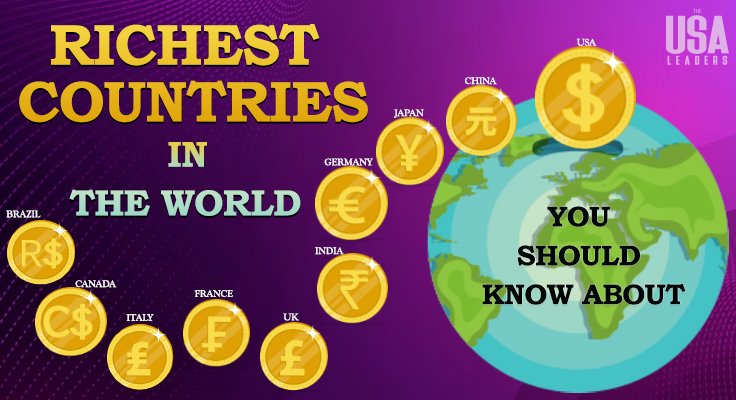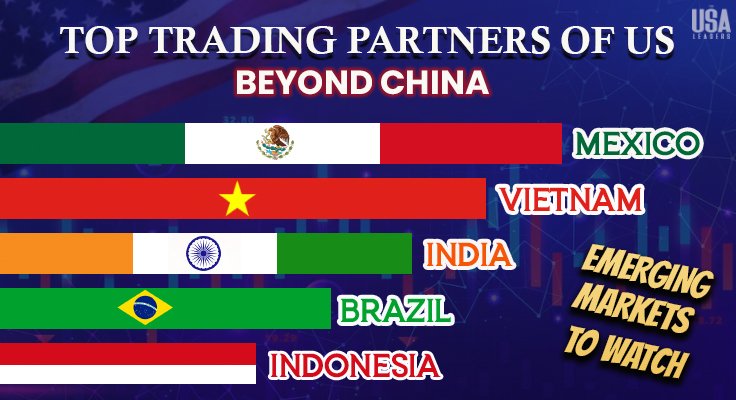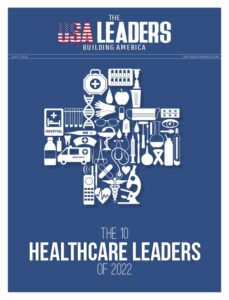Have you ever wondered what sets apart the richest countries in the world? It’s not just about GDP numbers; it involves factors like quality of life, healthcare, and education. Our journey is about to begin as we introduce you to the nations that lead in terms of wealth and prosperity. We’ll take a closer look at the things that have shaped their economies and societies. Join us as we explore the unique paths taken by these richest countries in the world by GDP to reach their coveted positions on the global stage.
1. United States Of America

- GDP: $26,854 Billion
- Capital city: Washington D.C.
- Population: 339.99 million
In 2023, the US, one of the richest countries in the world, is forecasted to achieve a modest GDP growth rate of 1.6%, primarily propelled by strong consumer spending and increased business investments. Nevertheless, potential obstacles such as surging inflation, global supply chain disruptions and the ongoing Ukraine conflict pose challenges to this growth.
Key highlights regarding the US GDP are its status as the world’s largest economy, representing approximately 20% of global GDP. It significantly surpasses China, the second-largest economy, by around 70%, and Japan, the third-largest, by nearly tenfold. The calculation of US GDP involves aggregating the total value of goods and services produced domestically within a year.
GDP plays a pivotal role in gauging economic size, and health, and monitoring parameters like economic growth, inflation, and unemployment rates. The primary drivers of GDP growth encompass consumer spending (70%) and business investment (about 20%), with government spending and net exports contributing to the remainder.
2. China
- GDP: $19,374 Billion
- Capital city: Beijing
- Population: 1.4126 billion
In Q1 2023, China’s GDP grew by 4.5%, rising to 6.3% in Q2, with a projected 5.1% growth for the year, according to the World Bank. Factors contributing to the slowdown include pandemic disruptions, a sluggish property market affecting investment, a government-led deleveraging campaign tightening credit, and the strain of an aging population on growth.
Despite this, China remains the world’s second-largest economy and a global growth driver. In 2022, its nominal GDP stood at $17.7 trillion, rising to a projected $18.6 trillion in 2023, with a GDP per capita of $12,814. Since 1978, it has averaged a 9.5% annual GDP growth rate.
China’s economic success is attributed to factors like opening up to foreign trade, government focus on development, and the hard work of its people, ensuring its continued significance in the global economy.
3. Japan

- GDP: $4,410 Billion
- Capital city: Tokyo
- Population: 123.3 million
In 2023, Japan’s nominal GDP is estimated to reach a staggering $4.4 trillion, securing its position as the third-largest economy globally. Projections for the country’s real GDP growth in the same year stand at a promising 1.3%, with a slight dip to 1.1% anticipated for 2024. These growth figures underscore the resilience and stability of Japan’s economy, driven primarily by robust domestic demand, with consumption and investment playing pivotal roles.
Further insights into Japan’s economic landscape reveal additional noteworthy statistics. The country boasts a GDP per capita of $35,400 in nominal terms and an even more impressive $51,800 when adjusted for purchasing power parity (PPP). With an impressively low unemployment rate of just 2.5%, Japan’s labor market exhibits remarkable stability. Simultaneously, the inflation rate holds steady at 2.5%, reflecting a harmonious balance in price levels.
Moreover, Japan maintains a substantial trade surplus, with a surplus of $180 billion. These figures collectively paint a picture of an economically powerful and well-balanced nation, indicative of Japan’s standing as a major player in the global economy.
4. Germany
- GDP: $4,309 Billion
- Capital city: Berlin
- Population: 83.29 million
Despite these challenges, Germany remains a strong economy with a high level of productivity. The government is taking steps to address the challenges, such as investing in infrastructure and education. However, it is too early to say whether these measures will be enough to ensure that Germany remains a leading economic power in the years to come.
In terms of key economic indicators, Germany boasts a substantial nominal GDP estimated at $4.3 trillion in 2023, reflecting its significant economic prowess. Additionally, the GDP per capita in Germany is estimated to be $52,000, indicating a relatively high standard of living for its citizens. On the global stage, Germany ranks as the fourth largest economy by nominal GDP and the fifth largest by purchasing power parity (PPP) GDP.
Germany’s economic landscape is characterized by diverse sectors, with manufacturing, services, and tourism being the primary contributors to its economic output. As a member of both the European Union and the eurozone, Germany plays a crucial role in the stability and growth of the broader European economy, further cementing its position as an influential player in the global economic arena.
5. India

- GDP: $3,740 Billion
- Capital city: New Delhi
- Population: 1.428 billion
India’s current GDP scenario is positive, driven by strong domestic demand, a favorable global environment, and key structural reforms like GST and IBC. Projections from the World Bank estimate GDP growth at 6.9% in 2023 and 6.3% in 2024. In Q1 2023, GDP growth exceeded expectations at 6.1%. The services sector leads, contributing 55%, followed by manufacturing at 25% and agriculture at 16%. The informal sector makes up about 90% of India’s economy, reflecting the complexities of one of the largest and fastest-growing richest countries in the world.
This growth has reduced poverty and improved living standards but challenges like persistent poverty and income inequality remain. The government is actively addressing these issues, and continued GDP growth will play a crucial role in further progress towards a more equitable and prosperous future.
6. United Kingdom
- GDP: $3,160 Billion
- Capital city: London
- Population: 67.7 million
The UK’s GDP is currently growing, though at a slower rate than in previous years. The Office for National Statistics (ONS) reports a 0.2% growth in GDP for the three months ending in June 2023, following a slight contraction of 0.1% in May and a 0.2% growth in April.
The International Monetary Fund (IMF) predicts a modest 0.4% GDP growth for the UK in 2023, a significant drop from the 4.1% growth achieved in 2022. This downward revision is attributed to factors such as the Ukraine conflict, rising inflation, and ongoing Brexit negotiations, posing substantial risks to the UK economy.
Key GDP figures for 2022 include a nominal GDP of $3.16 trillion and a PPP GDP of $3.85 trillion, with the UK ranking 6th globally in nominal GDP and 10th in PPP GDP. GDP per capita for 2022 was $46,800 (nominal) and $57,000 (PPP), while the unemployment rate stood at 3.6%, and inflation was at 7.9%.
Recent GDP growth is attributed to the economy’s gradual reopening post-COVID-19, government investments in infrastructure, and the resilience of the UK’s financial services sector.
7. France

- GDP: $2,924 Billion
- Capital city: Paris
- Population: 68.043 million
France’s current GDP scenario indicates modest growth, with a projected 0.8% increase in 2023 and 1.3% in 2024. The 2023 GDP is expected to reach 2802.00 USD Billion. The second-quarter rebound in 2023 was driven by net exports, while domestic demand remained weak, primarily due to high household savings. Inflation is a concern, expected to be at 6.1% in 2023 but gradually declining to 3.1% in 2024.
Several factors contributed to the slowdown, including the Ukraine conflict disrupting trade and energy prices, supply chain disruptions, and reduced consumer confidence due to high inflation. Nevertheless, the French government is taking measures like tax cuts and infrastructure investments to support growth. Additionally, the European Central Bank plans to raise interest rates to combat inflation and enhance export competitiveness. Despite challenges, the French economy is expected to grow, but risks, including further Ukraine conflict escalation and prolonged inflation, warrant careful monitoring.
8. Italy
- GDP: $2,170 Billion
- Capital city: Rome
- Population: 58.87 million
In the second quarter of 2023, Italy, one of the Richest Countries in the World, experienced its first GDP contraction since the pandemic, with a 0.4% decline, primarily due to reduced domestic demand, especially in construction investment. To counter this economic setback, Italy’s government has increased public spending and implemented tax cuts, but it’s unclear if these measures will suffice.
Key figures for Italy’s 2023 GDP include an estimated nominal GDP of $2.169 trillion, GDP per capita at approximately $35,370, an estimated 8.5% unemployment rate, and a projected public debt of 150% of GDP.
The economic slowdown results from a complex interplay of factors, including high inflation, rising interest rates, phased-out government support, and the indirect impact of the Ukraine conflict.
Italy’s economic outlook remains uncertain, dependent on variables like the Ukraine situation, inflation trends, and government responses to these evolving conditions.
9. Canada

- GDP: $2,090 Billion
- Capital city: Ottawa
- Population: 39.7 million
Despite challenges, Canada’s 2023 economic growth outlook remains positive. With near-record low unemployment and robust labor demand, the country shows resilience. Government support for businesses and consumers helps buffer potential slowdowns.
Key statistics regarding Canada’s GDP include the services sector comprising 70%, manufacturing at 15%, and natural resources contributing 10%. Additionally, Canada’s major trading partners include the United States, Mexico, and China, reflecting its global economic reach.
Overall, Canada’s GDP reflects a mixed scenario. While challenges may hinder growth, low unemployment and government backing provide a hopeful backdrop. The future trajectory will depend on how these elements interact in the coming months and years, but there is optimism for continued economic expansion.
10. Brazil
- GDP: $2,080 Billion
- Capital city: Brasília
- Population: 204 million
In 2022, Brazil’s GDP grew by 2.9%, primarily due to a 4.3% increase in household consumption. Unemployment dropped to 7.9%, the lowest since 2015. However, 2023 is expected to see GDP growth slow down to 0.8% due to monetary tightening, persistent high inflation at 10.2%, and weak global demand. The Central Bank raised interest rates to curb inflation, dampening economic growth. The Brazilian real depreciated against the US dollar, increasing import costs.
To counter these challenges, the Brazilian government has boosted infrastructure spending and offered tax breaks to businesses, though the effectiveness of these measures remains uncertain. Overall, Brazil’s current economic situation is mixed. The economy is still growing, but at a slower pace, with high inflation and global economic weakness as the primary concerns.
In conclusion, the list of the richest countries in the world showcases the intricate web of economic, social, and geopolitical dynamics that shape our global landscape. While GDP per capita is a significant measure, we must always bear in mind that genuine wealth transcends mere financial statistics. These nations serve as a reminder that true prosperity encompasses innovation, quality of life, and societal well-being. So, let us use this knowledge to inspire positive change, working together to create a better future for everyone.
ALSO READ: 10 Biggest states in the USA driving the Economy forward





















